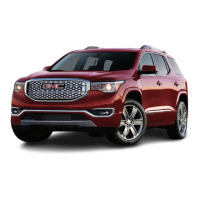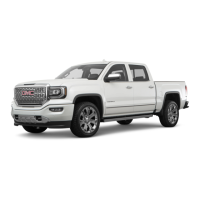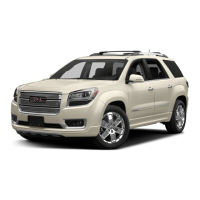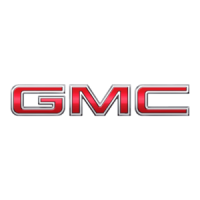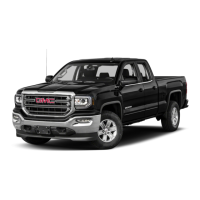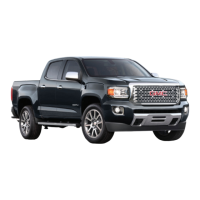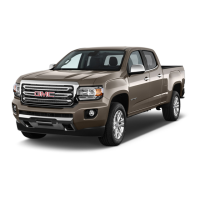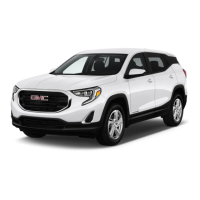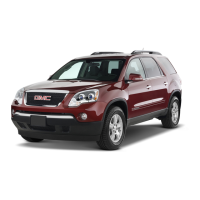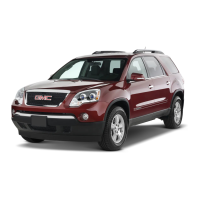Do you have a question about the GMC 2018 Acadia Denali and is the answer not in the manual?
Explains various symbols used in the manual and on vehicle labels for clear communication.
Provides an overview and diagram of the vehicle's instrument panel layout and labeled components.
Covers manual and power seat adjustments for front seats, including lumbar and recline functions.
Details the system for controlling heating, cooling, and ventilation using center stack controls.
Explains how to use cruise control, including setting speed, resuming, and disengaging the system.
Explains the function and operation of the Tire Pressure Monitor System (TPMS).
Details the operation and functions of the remote keyless entry transmitter for locking and unlocking.
Describes how to unlock, open, and close the liftgate, including power liftgate operation.
Covers theft-deterrent features, including the vehicle alarm and immobilizer systems.
Explains the operation of power windows, including express movement and automatic reversal system.
Details seat adjustment, power seat controls, lumbar support, and reclining seatbacks for front seats.
Provides instructions on proper seat belt usage, safety checks, and care for effective restraint.
Explains the vehicle's airbag system, including locations, deployment, and safety precautions.
Guides on selecting and properly installing child restraints for safety.
Describes various storage locations within the vehicle, including glove box and center console.
Explains the use and setup of the cargo management system for organizing items in the cargo area.
Explains the meaning and function of various warning lights, gauges, and indicators on the instrument cluster.
Covers customizable vehicle features and settings accessible through the infotainment system.
Explains how to connect and use Bluetooth devices for hands-free calling and audio streaming.
Describes how to connect smartphones for integrated access to apps and functions via USB.
Covers exterior lamp controls, including automatic headlamps and turn signals.
Details operation of interior lighting, including dome and reading lamps.
Provides instructions for operating the AM-FM radio, including station selection and favorites.
Explains how to use USB ports and auxiliary devices to play audio through the infotainment system.
Covers Bluetooth phone connectivity, call management, and making calls via steering wheel controls.
Explains the dual climate system for independent control of heating, cooling, and ventilation.
Details the replacement procedure for the passenger compartment air filter as part of routine maintenance.
Covers essential driving practices like avoiding distraction, maintaining following distance, and vehicle control.
Provides guidance on new vehicle break-in, ignition positions, and starting the engine.
Explains transmission operation, including manual mode and tow/haul mode for optimized performance.
Explains how to use cruise control, including adaptive cruise control and its limitations.
Covers features that help avoid crashes, like collision alerts, lane assist, and parking aids.
Provides information on recommended fuel, additives, and filling the fuel tank safely.
Offers guidance on towing, including general information, driving characteristics, and weight considerations.
Details DIY service tasks like checking fluids, belts, and filters for routine maintenance.
Covers engine oil selection, checking levels, and the oil life system for proper engine lubrication.
Explains the cooling system, coolant types, checking levels, and procedures for adding coolant.
Covers tire maintenance, including pressure, rotation, inspection, and replacement guidelines.
Provides step-by-step instructions for safely jump starting a vehicle with a dead battery.
Explains proper procedures for towing a disabled vehicle and recreational vehicle towing.
Provides guidance on cleaning and protecting the vehicle's exterior finish, including washing and paint care.
Offers advice on cleaning interior surfaces like leather, vinyl, and plastic to prevent damage and maintain appearance.
Emphasizes the importance of routine maintenance, recommending dealer services for optimal vehicle value.
Outlines owner checks, services, and required maintenance intervals for optimal vehicle condition.
Lists recommended fluids, lubricants, and replacement parts for vehicle maintenance.
Provides information on the Vehicle Identification Number (VIN) and its location on the vehicle.
Lists approximate capacities and specifications for various vehicle systems in metric and English units.
Details engine specifications, including horsepower, torque, and spark plug gap.
Explains how vehicle data is recorded, used, and protected to ensure privacy.
Describes the purpose and data recorded by the Event Data Recorder (EDR) in crash situations.
Explains various symbols used in the manual and on vehicle labels for clear communication.
Provides an overview and diagram of the vehicle's instrument panel layout and labeled components.
Covers manual and power seat adjustments for front seats, including lumbar and recline functions.
Details the system for controlling heating, cooling, and ventilation using center stack controls.
Explains how to use cruise control, including setting speed, resuming, and disengaging the system.
Explains the function and operation of the Tire Pressure Monitor System (TPMS).
Details the operation and functions of the remote keyless entry transmitter for locking and unlocking.
Describes how to unlock, open, and close the liftgate, including power liftgate operation.
Covers theft-deterrent features, including the vehicle alarm and immobilizer systems.
Explains the operation of power windows, including express movement and automatic reversal system.
Details seat adjustment, power seat controls, lumbar support, and reclining seatbacks for front seats.
Provides instructions on proper seat belt usage, safety checks, and care for effective restraint.
Explains the vehicle's airbag system, including locations, deployment, and safety precautions.
Guides on selecting and properly installing child restraints for safety.
Describes various storage locations within the vehicle, including glove box and center console.
Explains the use and setup of the cargo management system for organizing items in the cargo area.
Explains the meaning and function of various warning lights, gauges, and indicators on the instrument cluster.
Covers customizable vehicle features and settings accessible through the infotainment system.
Explains how to connect and use Bluetooth devices for hands-free calling and audio streaming.
Describes how to connect smartphones for integrated access to apps and functions via USB.
Covers exterior lamp controls, including automatic headlamps and turn signals.
Details operation of interior lighting, including dome and reading lamps.
Provides instructions for operating the AM-FM radio, including station selection and favorites.
Explains how to use USB ports and auxiliary devices to play audio through the infotainment system.
Covers Bluetooth phone connectivity, call management, and making calls via steering wheel controls.
Explains the dual climate system for independent control of heating, cooling, and ventilation.
Details the replacement procedure for the passenger compartment air filter as part of routine maintenance.
Covers essential driving practices like avoiding distraction, maintaining following distance, and vehicle control.
Provides guidance on new vehicle break-in, ignition positions, and starting the engine.
Explains transmission operation, including manual mode and tow/haul mode for optimized performance.
Explains how to use cruise control, including adaptive cruise control and its limitations.
Covers features that help avoid crashes, like collision alerts, lane assist, and parking aids.
Provides information on recommended fuel, additives, and filling the fuel tank safely.
Offers guidance on towing, including general information, driving characteristics, and weight considerations.
Details DIY service tasks like checking fluids, belts, and filters for routine maintenance.
Covers engine oil selection, checking levels, and the oil life system for proper engine lubrication.
Explains the cooling system, coolant types, checking levels, and procedures for adding coolant.
Covers tire maintenance, including pressure, rotation, inspection, and replacement guidelines.
Provides step-by-step instructions for safely jump starting a vehicle with a dead battery.
Explains proper procedures for towing a disabled vehicle and recreational vehicle towing.
Provides guidance on cleaning and protecting the vehicle's exterior finish, including washing and paint care.
Offers advice on cleaning interior surfaces like leather, vinyl, and plastic to prevent damage and maintain appearance.
Emphasizes the importance of routine maintenance, recommending dealer services for optimal vehicle value.
Outlines owner checks, services, and required maintenance intervals for optimal vehicle condition.
Lists recommended fluids, lubricants, and replacement parts for vehicle maintenance.
Provides information on the Vehicle Identification Number (VIN) and its location on the vehicle.
Lists approximate capacities and specifications for various vehicle systems in metric and English units.
Details engine specifications, including horsepower, torque, and spark plug gap.
Explains how vehicle data is recorded, used, and protected to ensure privacy.
Describes the purpose and data recorded by the Event Data Recorder (EDR) in crash situations.
| Brand | GMC |
|---|---|
| Model | 2018 Acadia Denali |
| Category | Automobile |
| Language | English |
